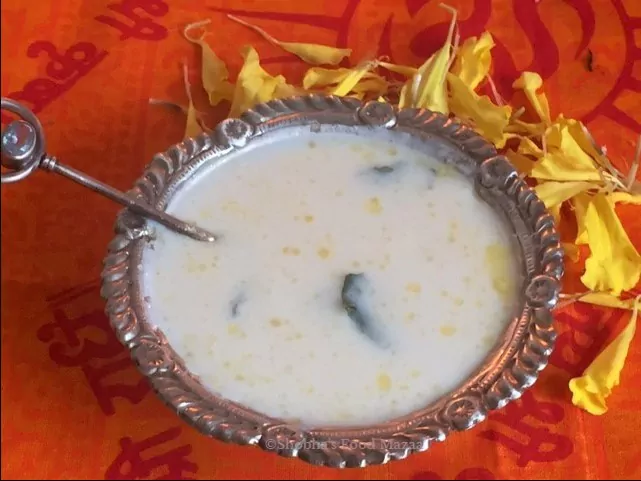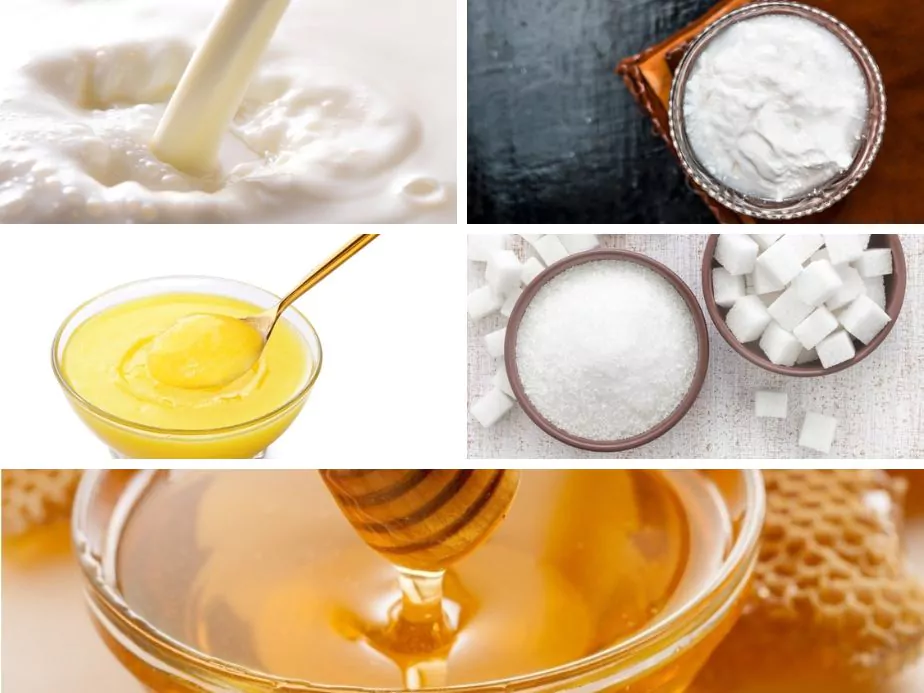How To Make Panchamrit at Home the Right Way?

Today, we delve into a cherished facet of Hindu traditions—the making of Panchamrit. Panchamrit (also spelled as Panchamrutham, Panchamrutha, or Panchamrut) holds a special place in Hindu rituals, symbolizing the unity of physical and spiritual elements.
Whether you’re preparing for a religious event or just curious about how to make Panchamrit, this comprehensive guide will take you through each step in detail. We’ll understand what Panchamrit is, its significance, and a traditional recipe to prepare this divine nectar at home.
1 What is Panchamrit?
Panchamrit, in Sanskrit, means ‘five nectars.’ This sacred preparation is a mixture of five ingredients—milk, yoghurt, honey, ghee (clarified butter), and sugar—each representing a particular essence of existence. Milk stands for purity and piousness, yoghurt for prosperity and progeny, honey for sweetness in speech and relationships, ghee for victory, and sugar for happiness.
2 Significance of Panchamrit
Panchamrit holds a central role in Hindu worship. It’s used in Abhishekam, a ritual of bathing the deity, symbolising the cleansing of the soul. The mixture is also consumed as Prasad (a divine offering) after prayers, signifying the acceptance of divine blessings.
3 How to Make Panchamrit: A Step-By-Step Guide
Let’s dive into the detailed steps of how to make Panchamrit. Here’s a simple and authentic recipe that you can easily follow.
Ingredients & Their Significance
- Milk (Dudh): Signifies purity and piousness.
- Curd (Dahi): Denotes prosperity and progeny.
- Honey (Madhu): Symbolises unity and sweet speech.
- Sugar (Chini/Sharkara): Represents happiness and bliss.
- Ghee (Clarified butter): Stands for victory and knowledge.
In addition to the primary ingredients, some people add tulsi (holy basil) leaves or dry fruits, but this varies by personal preference and regional traditions.
Preparation::

- Mix the Ingredients: Start by taking a clean, preferably unused bowl. Pour in the milk, followed by curd, honey, sugar, and ghee. The order of the ingredients has its roots in the scriptures and is believed to have specific spiritual implications.
- Stir Gently: Mix the ingredients gently. While stirring, remember the significance of each ingredient. This conscious engagement helps to imbue the Panchamrit with positivity and reverence.
- Rest and Settle: Let the Panchamrit rest for a few minutes so that the sugar can dissolve completely. During this time, the ingredients start to blend, creating a harmonious mixture, mirroring the unity and peace in life that Panchamrit symbolises.
- Strain: Strain the mixture to get a smooth, creamy Panchamrit. This step is optional and depends on personal preferences. Some prefer to keep the mixture unstrained as a sign of retaining all the goodness of the ingredients.
- Serve: The Panchamrit is now ready to be served. It is generally offered during pujas (worship ceremonies), particularly in rituals like Abhishekam, and later distributed among the devotees as ‘Prasad’.
Remember, while making Panchamrit, it’s essential to maintain cleanliness as it’s not just a dish—it’s an offering to the divine.
This easy-to-follow guide on how to make Panchamrit should help you prepare this sacred concoction with confidence and reverence. Whether you’re an adherent of Hindu traditions or just someone who appreciates the rich tapestry of cultural practices, the preparation of Panchamrit offers a fascinating glimpse into the spirituality embedded in culinary customs.
4 Tips and Variations
Even though the basic Panchamrit recipe remains the same, some regional variations and tips might be helpful:
- Addition of Fruits: Some regions prefer to add ripe bananas or coconut to Panchamrit, making it even richer. If you wish to add fruits, ensure they are ripe and mash them into a smooth consistency before adding them.
- Spices: A pinch of cardamom powder or saffron strands can be added for extra flavour. These are not traditionally part of Panchamrit but are often used in modern variations.
- Temperature: All ingredients should ideally be at room temperature before mixing to ensure the best texture and consistency.
- Order of Addition: While there’s no strict rule, it’s generally suggested to add ingredients in the following order – milk, yoghurt, ghee, honey, and then sugar.
5 The Cultural Significance of Panchamrit
Panchamrit carries a profound spiritual significance in Hinduism. Each ingredient carries a symbolic meaning contributing to a harmonious life. The act of preparing, offering, and consuming Panchamrit is an exercise of mindfulness, reverence, and devotion. It serves as a reminder of the balance of different aspects of life, represented through its five core ingredients.
6 Wrapping Up
Panchamrit, steeped in symbolism and spiritual significance, is a culinary emblem of Hindu rituals. When preparing Panchamrit, it’s not just about the mixing of ingredients; it’s a meditative process fostering an intimate connection with divinity.
This guide on “how to make Panchamrit” is intended to be both informative and easy to follow. While the simplicity of the recipe makes it accessible, the profound meaning attached to each ingredient makes the process deeply personal and spiritual.
In your journey to understanding and embracing diverse cultural practices, we hope this blog post has been helpful and enriching. Remember, the act of making Panchamrit is an exercise in devotion, and the joy lies as much in the process as in the final divine nectar that you create.
Feel free to share your experiences or any additional tips you might have for our readers interested in learning how to make Panchamrit. Your insights and anecdotes add value to our collective understanding of this beautiful tradition.
Community Q&A
About This Article
This article has been viewed 469 times.



